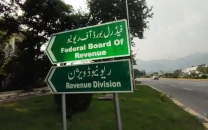IMF programme may do little to reduce trade deficit
Despite over 50% rupee depreciation, exports have remained stagnant

PHOTO: REUTERS
Opinion is divided over whether Pakistan should have gone back to the fund and whether the agreement with the multilateral donor will compound or mitigate the country’s macroeconomic problems. Pakistan has been seeking assistance from the IMF fairly regularly. In recent years, every elected government began its tenure by facing the question whether to seek the IMF assistance.
The Pakistan Peoples Party (PPP) government in 2008 and the Pakistan Muslim League-Nawaz (PML-N) government in 2013 didn’t take much time in answering the question in the affirmative and each concluded a credit agreement with the fund within a few months of coming to power.
The Pakistan Tehreek-e-Insaf (PTI) government flip-flopped on the question for months before deciding to draw the IMF’s capital.
Asad Umar discloses IMF demands for loan package
On each of these occasions, some renowned economists, not to speak of the parties in opposition, warned against obtaining credit from the fund on the argument that the IMF’s conditions would sap the economy of whatever strength it had been left with.
This gives rise to some logical questions. Why do economic managers, especially when on each occasion a different political party is at the helm, choose to play ball with the IMF in the face of advice to the contrary from some of the best names in the field? Do the economic managers lack understanding of possible implications of an IMF programme?
The IMF provides credit to the economies facing balance of payments (BOP) crisis. Under the EFF, a member country is provided a specified amount during a given period, usually in tranches, subject to the borrower’s compliance with performance criteria and other conditions embodied in the agreement. Typically, the IMF conditions stipulate a reduction in fiscal deficit, depreciation of domestic currency, flexible exchange rate, liberalisation of trade and investment regimes, privatisation of state-owned enterprises, tightening of monetary policy, increase in interest rate and overall deregulation of the economy. Thus, IMF-sponsored programmes have both political and economic implications. While accepting the IMF assistance, the borrowing country agrees to surrender part of its sovereignty to the fund during the period of loan programme.
The fund monitors the country’s fiscal, monetary and exchange rate policies with a view to ensuring that the agreed performance criteria are met. In this way, the IMF comes to exercise a lot of influence on economic decision-making of the borrowing country.
Focus of IMF programme
Though complete details of Pakistan’s current agreement with the IMF are not yet known, according to the fund, “the programme aims to support the authorities’ strategy for stronger and more balanced growth by reducing domestic and external imbalances, improving business environment, strengthening institutions, increasing transparency and protecting social spending.
IMF wanted 600bps interest rate hike: Asad Umar
To this end, the EFF will entail improving public finances and reducing public debt through tax policy and administrative measures, ensuring cost recovery in the energy sector and state-owned enterprises (SOEs), curtailing inflation and promoting infrastructure and human capital development. The envisaged measures will be anchored by comprehensive structural economic reforms.
The FY20 budget, which contains ambitious revenue targets and elimination of tax exemptions, such as GST zero-rating for the five major export-oriented sectors, together with intermittent increase in utilities’ tariffs in recent months, shows that the stabilisation measures are already afoot.
A country’s request for IMF credit signifies two things - the economy is in a critical condition and needs immediate injection of capital; and - given political and economic costs of the fund’s assistance - cash inflows from other potential sources are not coming through.
Thus, in an ideal situation, the country needs not to knock at the door of the IMF, or for that matter that of any other donor, for credit. But then in an ideal situation, Pakistan would not face massive fiscal, current account and trade deficits, and depletion of foreign exchange reserves. Again, in an ideal situation, the affluent expatriates will invest heavily in Pakistan. However, we live in the actual world and the country is in the throes of economic crisis. When a country is precariously placed politically or economically, the dominant trend is capital flight rather than capital inflows.
Capital movement is guided inexorably by two factors, viz safety of investment and higher returns. In short, it is very much doubtful whether there was any alternative to swallowing the bitter pill of the IMF’s conditionality-linked assistance.
Bailout or pro-poor package
Regarding the possible impact of the programme, it is a bailout and not a development or pro-poor package. The purpose is to help the country service its debt, make payment for imports and build up its reserves. The goal of social-sector development is at best a sugar-coated pill to make an otherwise difficult programme digestible.
The assistance from the IMF will thus save the country from default on debt repayment and make it possible to pay for imports. Now, what we import from the IMF money is another issue.
World Trade Organisation (WTO) rules allow a country facing a BOP problem to temporarily restrict imports. But the IMF would not allow the government to impose such restrictions as an open trade regime forms the kernel of an IMF programme.
The reserves buildup from the IMF assistance and the enhanced possibility of capital inflows from other donors in the wake of an agreement with the fund will increase Pakistan’s credit rating and convey a positive signal to the domestic foreign exchange market and may bring some stability, in the short run, to the rupee-dollar parity.
However, in the long run, the exchange value of the rupee will be determined by relative demand for (imports and debt servicing) and supply of (exports and foreign capital inflows) foreign exchange. A continuing adverse balance of trade will put pressure on the reserves and push the rupee further down.
The IMF-sponsored programme can contribute little to reducing the trade deficit, which is the major component of current account deficit and the principal source of BOP problem. The past one year has seen the rupee depreciate by nearly 50%, but exports have remained stagnant - $22.34 billion in first 11 months of FY19 compared with $22.75 billion in the corresponding period of FY18.
Imports have declined nearly $3 billion but that is due to the slowdown of the economy from 5.5% in FY18 to 3.3% in FY19.
A country’s trade deficit is primarily undergirded by productivity constraints, which exchange rate movements can hardly help address. In fact, the depreciation makes imports expensive and thus worsens terms of trade (the ratio of export and import prices).
As a result, an economy’s ability to import capital equipment, which is essential for growth, is hampered.
Is IMF credit a credible solution?
The government’s reduced borrowing from the central bank and a restrictive monetary policy in the form of interest rate hike may help contain inflation. However, this applies only to the demand-side inflation. Such measures are of little help in containing the supply-side inflation, which may aggravate as increased inflationary pressures act as a drag on investment and growth. Not surprisingly, economic growth is projected to decelerate further to 2.4% and inflation rate is projected to increase to 13% in FY20.
Thus, the upcoming IMF programme is not likely to provide a credible solution to Pakistan’s economic problems. This is also confirmed by past such programmes. Economic managers are also aware of this. However, as always, the government’s priority is to ward off the immediate crisis - as in the long run we all will be dead - for which the IMF credit appears to be the only option. It is like administering a pain killer to a patient, who is finding it extremely difficult to endure the excruciating pain.


















COMMENTS
Comments are moderated and generally will be posted if they are on-topic and not abusive.
For more information, please see our Comments FAQ